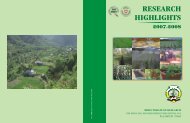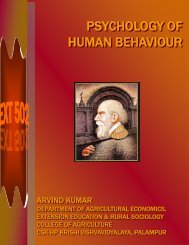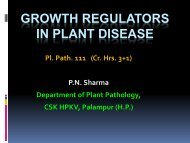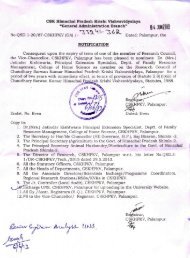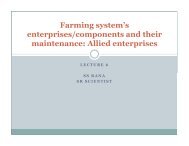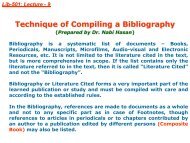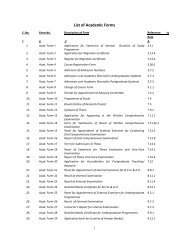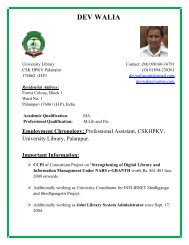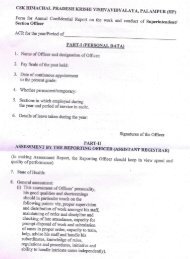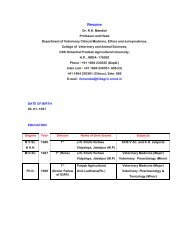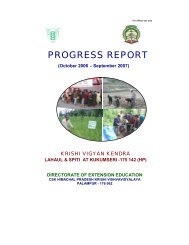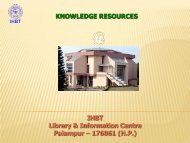animal production - CSK Himachal Pradesh Agricultural University ...
animal production - CSK Himachal Pradesh Agricultural University ...
animal production - CSK Himachal Pradesh Agricultural University ...
Create successful ePaper yourself
Turn your PDF publications into a flip-book with our unique Google optimized e-Paper software.
(i) Liming: Liming of the pond is necessary to eradicate the harmful insects, micro-organisms, to render soil alkaline<br />
and provide calcium to the growing fish. If soil is not acidic, the lime can be used at the rate of 25 g per sq m and if soil is<br />
acidic, increase the quantity of lime by 50%. After broadcasting of lime in whole tank, it must be left dry for 4 days to one<br />
week.<br />
(ii) Manuring: Manuring is done with the objective to increase the plankton which form the natural food of the fish.<br />
The rate of manure depends on the fertility status of soil. The organic manure such as cow dung is used @ 20 tonnes/ha<br />
i.e. 2 kg per sq m area in Palampur valley. Initial manuring is to be done with 50% of total required manure and<br />
subsequently the rest 50% should be used in the equal monthly installments. Fill the tank with water just after manuring and<br />
leave it for 12-15 days.<br />
(iii) Control of aquatic weeds and predators: The algal blooms are sudden out-bursts due to higher manuring or<br />
organic effluent. These blooms liberate good amount of carbon dioxide leading to oxygen depletion which can cause large<br />
scale mortality. If reddish scum appears on the surface of the water, this means the outbreak of algal bloom. The manuring<br />
and artificial feeding should be stopped immediately and allow fresh water in the pond. If the algal blooms are in excess,<br />
spray 3% copper sulphate solution selectively to worst affected areas of pond or superphosphate at the rate of 1 g/m water<br />
area. The eradication of weed and predatory fishes is necessary to avoid competition with culturable fishes for space and<br />
food. These fishes may be eradicated either by repeated netting or draining the water or poisoning the pond. Generally<br />
used poisons for this purpose are mahua oilcake (200 ppm), 1% tea seedcake or turpentine oil @ 250 1/ha. The other<br />
chemicals such as Aldrin (0.2 ppm) and Endrin (0.01 ppm) can also be used. In case of the use of these chemicals, the<br />
stocking of fish seed (fry/fingerlings ) may be delayed atleast by 10 to 25 days so as to facilitate elimination of the chemicals/residues.<br />
Stocking<br />
Judicious selection of compatible fast growing species is of vital importance in maximizing fish <strong>production</strong>. A<br />
combination of three species viz. mirror carp, grass carp and silver carp fulfills the species selection requirements and this<br />
model has proven to be the ideal combination for sub-temperate region of the State. Of these, mirror carp is a bottom<br />
feeder, grass carp is a macro-vegetation feeder and silver carp is surface feeder.<br />
Species ratio<br />
Selection of species ratio generally depends upon the local conditions, seed availability, nutrient status of pond,<br />
etc. The species ratio in the recommended model for Zone II is - 3 mirror carp : 2 grass carp : 1 silver carp.<br />
Stocking details<br />
Rate of stocking usually depends on the fertility of the pond and the measures adopted to increase its biological<br />
productivity by manuring, artificial feeding, monitoring of growth and maintaining good health of fish. The rate of stocking<br />
recommended for this zone is 15,000 fingerlings per ha with artificial feeding.It is good to stock the ponds with fingerlings of<br />
40-60 mm size for better survival and high <strong>production</strong>. It is better to stock the pond after 15 days of manuring in early hours<br />
of day or in the evening. The cloudy day or warmer part of day is to be avoided for stocking.<br />
Supplementary feeding<br />
The level of natural food organisms in the fish culture ponds can not be maintained to the required extent even<br />
after manuring. Hence, supple-mentary feeding with diet rich in protein,carbohydrates and fats is essential for higher rate of<br />
fish growth. The ingredients generally used for artificial feeding are groundnut oil cake and wheat bran in the ratio of 1:1.<br />
Feed should be preferably provided in the form of pellets or bowls @ 2% of the total biomass and feed them by hand at<br />
different places in the ponds so that all the fishes must get uniform quantity of feed for their uniform growth.<br />
Grass carps are to be fed with chopped succulent grass or discarded vegetable leaves. Kitchen refuse can also be<br />
used as supplementary feed for fish culture.<br />
A practical feed formula which is in practice at Fish Farm,<strong>CSK</strong>HPKV is given below:<br />
Ingredients Ingredients Qty for preparing<br />
(%) 10 kg feed<br />
37



